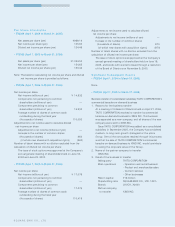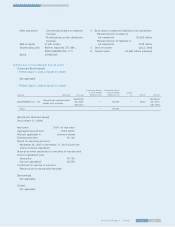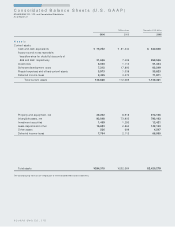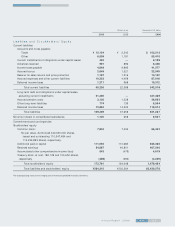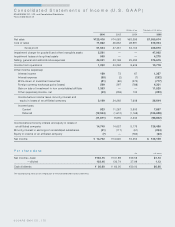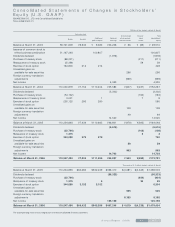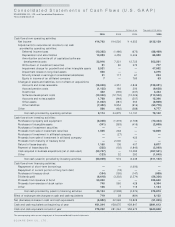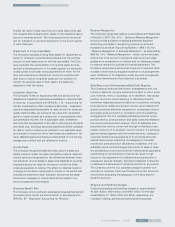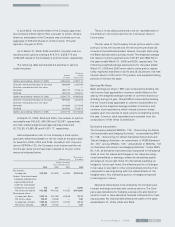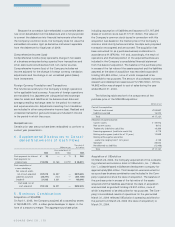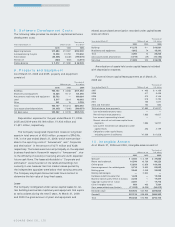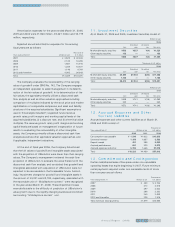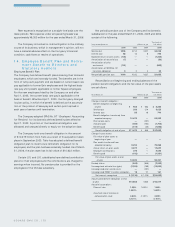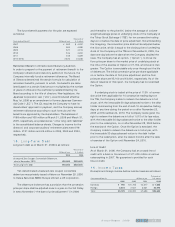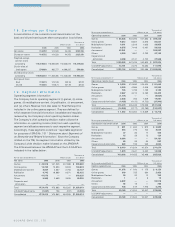Square Enix 2006 Annual Report Download - page 54
Download and view the complete annual report
Please find page 54 of the 2006 Square Enix annual report below. You can navigate through the pages in the report by either clicking on the pages listed below, or by using the keyword search tool below to find specific information within the annual report.
S Q U A R E E N IX C O . , L T D .
Advertising Expenditures
The Company recognizes advertising expense as it is incurred
except for cooperative advertising. Cooperative advertising
obligations are accrued and amortized at the same time the
related revenues are recognized. Total advertising expense was
approximately ¥7,458 million, ¥5,346 million and ¥5,119 million
for the year ended March 31, 2006, 2005 and 2004, respectively.
Recently Issued Accounting Pronouncements
In November 2004, the Financial Accounting Standards Bord
(“ FASB” ) issued SFAS No. 151, Inventory Costs, an amendment
of ARB No. 43. This statement clarifies the accounting for idle
capacity expense, freight, handling costs, and wasted material
and is effective for inventory costs incurred during fiscal years
beginning after June 15, 2005. The Company believes the
adoption of this statement will not have a material effect on
its results of operations, cash flows or financial position.
In December 2004, the FASB issued SFAS No. 123(R), Share
Based Payment. This statement establishes standards for the
accounting for transactions in which an entity exchanges its
equity instruments for goods and services. It focuses primarily on
accounting for transactions in which an entity obtains employee
services in share-based payment transactions (employee stock
options). The statement requires the measurement of the cost
of employee services received in exchange for an award of
equity instruments (such as employee stock options) at fair
value on the grant date. That cost will be recognized over the
period during which an employee is required to provide services
in exchange for the award (the requisite service period). This
statement is effective as of the beginning of the first annual
reporting period that begins after December 15, 2005. The
Company is adopting transition methods under this standard.
In December 2004, the FASB issued SFAS No. 153, Exchanges
of Non-monetary Assets, an amendment of APB 29. This state-
ment clarifies that all non-monetary transactions that have
commercial substance should be recorded at fair value and is
effective for the fiscal periods beginning after June 15, 2005.
The Company believes the adoption of this statement will not
have a material effect on its results of operations, cash flows or
financial position.
In June 2005, the EITF Issue No. 05-6, Determining the
Amortization Period for Leasehold Improvements Purchased
after Lease Inception or Acquired in a Business Combination.
Issue No. 05-6 states that leasehold improvements that are
placed in service significantly after the beginning of the lease
term should be amortized over the shorter of the useful life of
the assets or a term that includes required lease periods and
renewals that are deemed to be reasonably assured at the date
the leasehold improvements are purchased. The pronounce-
ment is effective for leasehold improvements that are purchased
or acquired in reporting periods beginning after June 29, 2005.
The Company believes the adoption of this issue has had no
material impact on its consolidated financial statements.
In June 2005, the FASB issued FSP No. FAS 150-5. This FSP
clarifies that freestanding warrants and other similar instru-
ments on shares that are redeemable (either puttable or
mandatorily redeemable) should be accounted for as liabilities
under FASB Statement No. 150, Accounting for Certain Finan-
cial Instruments w ith Characteristics of Both Liabilities and
Equity, regardless of the timing of the redemption feature or
price, even though the underlying shares may be classified as
equity. This FSP is effective for the first reporting period begin-
ning after June 30, 2005. The Company believes the adoption
of this issue has had no material impact on its consolidated
financial statements.
Stock-Based Compensation
The Company accounts for its incentive stock option plans using
intrinsic value method in accordance with Accounting Principles
Board Opinion No. 25, “ Accounting for Stock Issued to Employ-
ees” (“ APB25” ). Under APB25, generally no compensation
expenses are recorded when the terms of the award are fixed
and the exercise price of the stock option equals or exceeds
the fair value of the underlying stock on the date of grant.
In fiscal 2003, the Company adopted the disclosure provisions
of SFAS No. 148 “ Accounting for Stock-Based Compensation-
Transaction and Disclosure—an Amendment of FASB Statement
No. 123” , which provides alternative methods of transition for
a voluntary change to the fair value based method of accounting
for stock-based employee compensation.
On April 1, 2003, the Company took over SQUARE’s stock
option plan as a result of the merger, pursuant to which, the
directors, officers and employees of former SQUARE may pur-
chase up to an aggregate of 3,330,895 shares of common
stock of the Company. This plan expires in the year of 2009.
In June 2004, the stockholders of the Company approved
the Company’s Stock Option Plan, pursuant to which, officers,
directors, employees of the Company may purchase up to an
aggregate of 600,000 shares of common stock. This plan
expires in the year of 2009.


